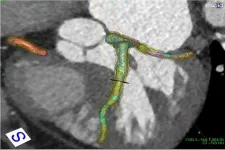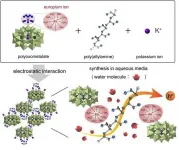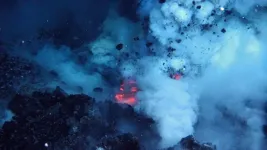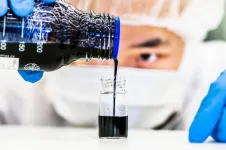(Press-News.org) The Endangered dryas monkey (Cercopithecus dryas), endemic to the Democratic Republic of the Congo, is one of Africa's most mysterious primates. The discovery of the dryas monkey killed by a hunter in the buffer zone of Lomami National Park in 2014 has prompted field research of this small species (5-7 pounds). However, they are difficult to detect because they live in dense vegetation in secondary forest thickets.
Using non-invasive research and no-flash camera traps from 2014 to 2019, scientists from Florida Atlantic University in collaboration with researchers from the FZS-Lomami Project, Democratic Republic of the Congo, now have picture-perfect details on this elusive species. They have confirmed the occurrence of the dryas monkey at seven locations in both Lomami National Park and its buffer zone spanning a total area of 3,453 square kilometers, based on opportunistic reports provided by local village residents and park patrols.
Their findings, published in Oryx--The International Journal of Conservation, indicate that Lomami National Park and its buffer zone contain the greatest extent of the species' known range, and Lomami is the only national park with a confirmed population.
Although camera traps - a method for capturing wild animals on film when researchers are not present - are widely used to detect and survey cryptic species, the FAU scientists had to develop specific camera trap methods and placements to reliably detect the dryas monkeys.
Daniel Alempijevic, M.S., first author and a doctoral student at FAU, and Kate Detwiler, Ph.D., senior author and an associate professor in the Department of Anthropology in FAU's Dorothy F. Schmidt College of Arts and Letters, developed a species-specific multi-strata (0 to 29 meters) camera-trap technique to detect the species with a placement of three camera traps at each survey point, one each monitoring the ground, understory and canopy.
Alempijevic positioned the camera traps on game paths (0.2 to 0.5 meters above ground), shrubs and liana tangles (1.5 to 10 meters), and horizontal limbs (14.9 to 29 meters) forming pathways to adjacent tree crowns. He used a single rope technique to access the canopy, and a double-rope technique to move to the desired camera-trap location when needed. With the solicited information on the dryas monkeys from the residents of villages, he selected specific sites for camera-trap surveillance.
"We selected Bafundo Forest in the buffer zone for camera-trap surveillance, starting at the location where the first reported dryas monkey was killed by a hunter," said Detwiler. "We established the second survey site 40 kilometers west of Bafundo Village, at Camp Bartho in Lomami National Park after a ranger patrol team saw a dryas monkey there in 2014."
Camera traps accumulated 1,742 trap days on the ground, 2,821 trap days in the understory and 2,927 trap days in the canopy. Understory camera traps recorded 32 dryas monkey events, canopy camera traps detected a single event, and dryas monkeys were not detected by camera traps at ground level. The cameras that detected the species most frequently were those in the lower strata of the canopy and understory, at 2 to 10 meters above ground. At least 365 trap days are required to achieve a 95 percent detection probability, although dryas monkeys may be detected sooner in suitable habitats.
"Our camera-trap placements detected dryas monkeys almost exclusively in the understory across all surveys, regardless of canopy structure, which supports our hypothesis that the species appear to prefer structurally complex understories and forest edges," said Alempijevic. "Because our camera traps on the ground did not detect dryas monkeys, it seems unlikely that they travel on the ground. Only one camera trap in the canopy detected a dryas monkey, suggesting that they rarely travel in the upper canopy."
The researchers note that high heterozygosity and low inbreeding measures from genomic analysis of a hunter-killed dryas monkey (collected on Oct. 26, 2014) from Bafundo Forest suggest that it was a representative of a larger contiguous population.
"We recommend that researchers and conservationists working in the central basin of the Democratic Republic of the Congo mobilize local knowledge to identify other areas where the dryas monkey occurs and confirm any reports using our species-specific camera-trap placement technique," said Detwiler.
INFORMATION:
Study co-authors are John A. Hart, Ph.D., and Terese B. Hart, Ph.D., Frankfurt Zoological Society, FZS-Lomami Project, Democratic Republic of the Congo.
L'Institut Congolais pour la Conservation de la Nature granted research permission to work in Lomami National Park. The local chiefs of Bafundo, Likandjo and Bote villages and the Balanga sector chief of Maniema Province granted permission to access the forest.
Funding for this research was generously provided by the Margot Marsh Biodiversity Foundation, Mohammed Bin Zayed Species Conservation Fund, FAU, Primate Conservation Incorporated, the Lukuru Foundation, International Primatological Society, Dynamic Youth Community and Indigogo crowd funding.
About Florida Atlantic University:
Florida Atlantic University, established in 1961, officially opened its doors in 1964 as the fifth public university in Florida. Today, the University serves more than 30,000 undergraduate and graduate students across six campuses located along the southeast Florida coast. In recent years, the University has doubled its research expenditures and outpaced its peers in student achievement rates. Through the coexistence of access and excellence, FAU embodies an innovative model where traditional achievement gaps vanish. FAU is designated a Hispanic-serving institution, ranked as a top public university by U.S. News & World Report and a High Research Activity institution by the Carnegie Foundation for the Advancement of Teaching. For more information, visit http://www.fau.edu.
Astronomers have discovered a pulsar--a dense and rapidly spinning neutron star sending radio waves into the cosmos--using a low-frequency radio telescope in outback Australia.
The pulsar was detected with the Murchison Widefield Array (MWA) telescope, in Western Australia's remote Mid West region.
It's the first time scientists have discovered a pulsar with the MWA but they believe it will be the first of many.
The finding is a sign of things to come from the multi-billion-dollar Square Kilometre Array (SKA) telescope. The MWA is a precursor telescope for the SKA.
Nick Swainston, a PhD student at the Curtin University node of the International Centre for Radio Astronomy Research (ICRAR), made the discovery while processing data collected as part ...
Coronary artery disease (CAD) is the most common form of heart disease and is present in about END ...
Protons are the next big thing when it comes to fuel cell technology. The subatomic exchange produces power on a scale that challenges contemporary solid-state fuel cell technology, used to help power space shuttles. To realize the proton-based technology sooner, an international team of researchers have developed a hybrid material that effectively transports protons at high temperatures and humidity -- two major challenges in past attempts.
The results were published on April 19 in ACS Applied Materials & Interfaces, a journal of the American Chemical Society.
The team, led by ...
A new Portland State study challenges the idea that youth with cognitive disabilities are unable or lack potential to pursue a career in science, technology, engineering and mathematics.
In a study using national data on more than 15,000 adolescents, the researchers found that undergraduates with medicated ADHD or autism appear to be more likely to major in STEM than youth without cognitive disabilities, and youth with autism have the most positive STEM attitudes.
Dara Shifrer, the lead author and an associate professor of sociology at PSU, says that increasing access to STEM fields for youth with disabilities depends not only on encouraging them to pursue STEM majors but also to enroll in college because STEM occupations often require bachelor's degrees at ...
Graphene is a two-dimensional material in which carbon atoms are arranged in hexagonal structures, and it has unique physical and chemical properties such as sub-nanometer thickness, chemical stability, mechanical flexibility, electrical and thermal conductivity, optical transparency, and selective permeability to water. Due to these properties, various applications of graphene in transparent electrodes, desalination, electrical energy storage, and catalysts have been vigorously studied.
Because graphene is an extremely thin material, for practical uses, it has to be deposited on top of other materials that serve as substrate. One of the research subjects which is of great scientific ...
Osaka, Japan - Catalysts lie at the heart of a greener and more sustainable future for chemical production. However, many of the catalysts currently in widespread use have limitations that affect their efficiency. Researchers from Osaka University have reported a stable and reusable nickel phosphide nanoalloy catalyst for the hydrogenation of maltose to maltitol that outperforms conventional catalysts. Their findings are published in ACS Sustainable Chemistry & Engineering.
Maltitol is a sugar alcohol that is widely used as a sweetener and food additive. It can be produced by hydrogenating maltose; however, the reaction must be selective to avoid generating ...
DALLAS, April 21, 2021 -- A smartphone-based electrocardiogram (ECG) screening accurately detected previously unknown atrial fibrillation in American Indians, and more than half who were diagnosed with the irregular heart rhythm were younger than the recommended screening age of 65, according to new research published today in the Journal of the American Heart Association, an open access journal of the American Heart Association.
About one-third of ischemic strokes, those triggered by blood clots, are caused by atrial fibrillation, the most common heart rhythm disorder. Since many people don't have symptoms and are unaware of its presence, atrial fibrillation often goes undiagnosed. In some cases, a stroke is the first sign that a person has the ...
Volcanic eruptions deep in our oceans are capable of extremely powerful releases of energy, at a rate high enough to power the whole of the United States, according to research published today.
Eruptions from deep-sea volcanoes were long-thought to be relatively uninteresting compared with those on land. While terrestrial volcanoes often produce spectacular eruptions, dispersing volcanic ash into the environment, it was thought that deep marine eruptions only produced slow moving lava flows.
But data gathered by remotely operated vehicles deep in the North East Pacific and analysed by scientists at the University of Leeds, has revealed a link ...
Researchers at Linköping University, Sweden, have developed a stable high-conductivity polymer ink. The advance paves the way for innovative printed electronics with high energy efficiency. The results have been published in Nature Communications.
Electrically conducting polymers have made possible the development of flexible and lightweight electronic components such as organic biosensors, solar cells, light-emitting diodes, transistors, and batteries.
The electrical properties of the conducting polymers can be tuned using a method known as "doping". In this method, various dopant molecules are added to the polymer ...
Despite virtual reality (VR) technology being more affordable than ever, developers have yet to achieve a sense of full immersion in a digital world. Among the greatest challenges is making the user feel as if they are walking.
Now, researchers from the Toyohashi University of Technology and The University of Tokyo in Japan have published a paper to the journal Frontiers in Virtual Reality describing a custom-built platform that aims to replicate the sensation of walking in VR, all while sitting motionlessly in a chair.
"Walking is a fundamental and fun activity for human in everyday life. Therefore, it is very worthwhile to provide a high-quality walking experience in a VR space," says Yusuke Matsuda.
Matsuda is a project ...






